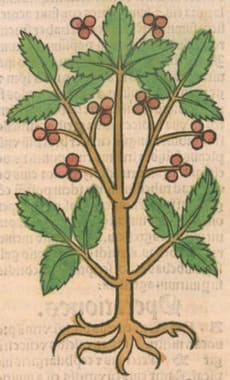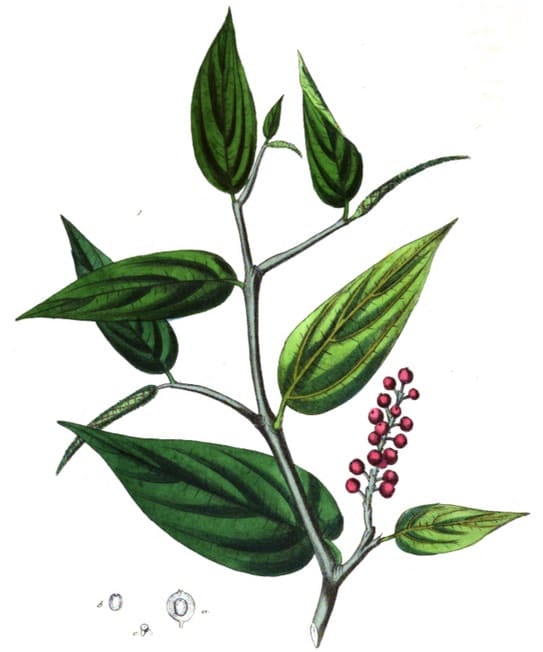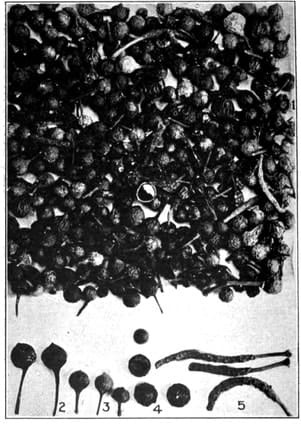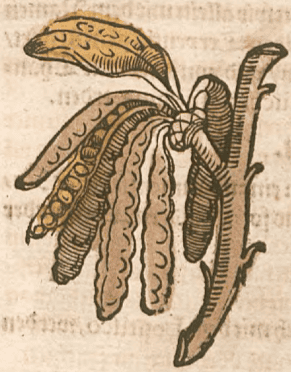Cubeba, Cubeb
Bi Cheng Qie (TCM)Kankola, Kokola, Kankola, Takkola, Kolaka (Ayurveda)
Kabanchini, Kababah, Habb-ul-Uruus (Unani)
Valmilaku (Siddha)
 Ortus Sanitatis, Meydenbach, 1491
Ortus Sanitatis, Meydenbach, 1491 Medical Botany, Bohn, 1832
Medical Botany, Bohn, 1832 CUBEB
CUBEB1. Many fruits. 2. Large fruits. 3. Small fruits. 4. Seed in the pericarp. 5. Stems.
Squibb’s Atlas of the Official Drugs, Mansfield, 1919
Botanical name:Piper cubeba (primary) Litsea cubeba Parts used:Fruit Temperature & Taste:Warm, dry. Pungent “According to some people it elicits some cooling effects alongwith its inherent hotness. Actually cubeb is hot and dry upto the second degree”. (Avicenna) Classifications:2A APERIENT MEDICINES 3D. CORDIALS & CARDIACS 3E. DIURETIC 3P. MASTICATORIES & STERNUTATORIES 4a. CEPHALIC 4c. CARDIAC 4e. STOMACHIC 4h. NEPHRITIC TCM: M. Warm to Clear Cold T. External Medicines |
 Cubeb fruit, Krauterbuch, Lonitzer, 1578
Cubeb fruit, Krauterbuch, Lonitzer, 1578 |
Uses:
1. Clears Cold from Stomach, Promotes Digestion:
-Nausea, Vomiting, hiccup
-Indigestion; Poor Appetite
“used in Hepatic obstructions” (Avicenna)
2. Warms the Kidneys, Clears Damp:
-difficult urination, dribbling urine, constant desire to urinate
-Cystitis, Urethritis
-Prostate disorders
-Gonorrhea, Leukorrhea
-Gravel and Stones (proven effect)
3. Clears Phlegm, Stops Cough:
-Cough with Cold phlegm; chronic Bronchitis
-Loss of Voice (Ayurveda, Charaka)
-benefits the Voice; Laryngitis, Bronchitis (Unani)
-“When kept in mouth, it clears the voice”. (Avicenna)
4. Clears Wind and Cold, Strengthens the Head:
-cold diseases of the Head; Dullness, Lethargy, Cold Headache
-previously to promote courage and confidence
-produces Euphoria (traditional use)
5. Externally:
-in Tooth powders, gargles and mouth washes to strengthen the Teeth and Gums, and for diseases of them.
-“used for in putrid Ulcers of the Gums” (Avicenna)
-freshens the breath if held in the mouth
-paste applied to the genitals of both sexes to intensify pleasure during sexual intercourse.
-“It cleanses urinary tracts, facilitates the flow of sandy materials through the urine and removes Kidney and Bladder Stones.” (Avicenna)
-“Local use of saliva secreted by chewing cubeb enhances coital pleasure in women” (Avicenna)
Dose:
Powder: 1–3 grams
Corrective:
White Sandalwood, Rose, Pistachia Galls (Unani)
Substitutes:
1. Black Pepper, Cardamon, Cinnamon (Unani)
2. “The potency of Cubeb is similar to that of madder but it is more attenuant” (Avicenna)

Main Combinations:
1. To open the Liver, Cubeb with Amomum and Sandalwood
2. Gonorrhea:
i. Cubeb with Cream of Tartar
ii. Cubeb with Alum
iii. Cubeb (1 dram) with Ammonium chloride, Licorice (1 scruple each)
3. Urinary stones, Cubeb with Cyperus rotundus (Unani, proven effect)
4. Errhine, Cubeb with Valerian root (Memorial Pharmaceutique, 1824)
Cautions:
1. Not for Heat with Yin deficiency
2. Avoid in Nephritis and Inflammatory conditions of the Gastro-intestinal tract
Main Preparations used:
Confection, Distilled Oil, Species Diacubeb
-
Extra Info
-
History
|
‘Cubebs have been introduced into medicine by the Arabian physicians of the middle ages, who describe them as having the form, colour, and properties of pepper. Masudi in the 10th century stated them to be a production of Java. Edrisi, the geographer, in A.D. 1153 enumerated them among the imports of Aden. Among European writers, Constantinus Africanus of Salerno was acquainted with this drug as early as the 11th century; and in the beginning of the 13th its virtues were noticed in the writings of the Abbess Hildegard in Germany, and even in those of Henrik Harpestreng in Denmark. Cubebs are mentioned as a production of Java (“grantisle de Javva“) by Marco Polo; and by Odoric, an Italian friar, who visited the island about forty years later. In the 13th century the drug was an article of European trade, and would appear to have already been regularly imported into London. Duty was levied upon them as Cubebas silvestres at Barcelona in 1271. They are mentioned about this period as sold in the fairs of Champagne in France, the price being 4 sows per lb.10 They were also sold in England: in accounts under date 1284 they are enumerated with almonds, saffron, raisins, white pepper, grains [of paradise], mace, galangal, and gingerbread, and entered as costing 2s. per lb. In 1285— 2s. 6d. to 3s. per lb.; while in 1307, 1 lb. purchased for the King’s Wardrobe cost 9s. From the journal of expenses of John, king of France, while in England during 1359-60, it is evident that cubebs were in frequent use as a spice. Among those who could command such luxuries, they were eaten in powder with meat, or they were candied whole. A patent of pontage granted in 1305 by Edward I., to aid in repairing and sustaining the Bridge of London, and authorizing toll on various articles, mentions among groceries and spices, cubebs as liable to impost. |
Cubebs occur in the German lists of medicines of Frankfort and Nordlingen, about 1450 and 1480; they are also mentioned in the Confectbuch of Hans Folcz of Nuremberg, dating about 1480. It cannot however be said that cubebs were a common spice, at all comparable with pepper or ginger, or even in such frequent use as grains of paradise or galangal. Garcia de Orta (1563) speaks of them as but seldom used in Europe; yet they are named by Saladinus as necessary to be kept in every apotheca. In a list of drugs to be sold in the apothecaries’ shops of the city of Ulm, A.D. 1596, cubebs are mentioned as Fructus carpesioimm vel cubebarum, the price for half an ounce being quoted as 8 kreuzers, the same as that of opium, best manna, and amber, while black and white pepper are priced at 2 kreuzers. Although it was always well known that the cubebs were a product of Java and that island is stated to have exported in 1775 as much as 10,000 lb. of this spice, its mother plant was made known only in 1781 by the younger Linnaeus. The action of cubebs on the urino-genital organs was known to the old Arabian physicians. Yet modern writers on materia medica even at the commencement of the present century, mentioned the drug simply as an aromatic stimulant resembling pepper, but inferior to that spice and rarely employed,’— in fact it had so far fallen into disuse that it was omitted from the London Pharmacopoeia of 1809. According to Crawfurd, its importation into Europe, which had long been discontinued, recommenced in 1815, in consequence of its medicinal virtues having been brought to the knowledge of the English medical officers serving in Java, by their Hindu servants.’ (Pharmacographia, Fluckiger & Hanbury, 1879) |
